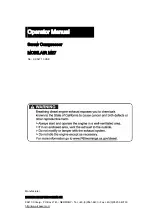
- 11 -
1.4
Safety during use and
operation
1
When the unit has to operate in a fire-hazardous
environment, each engine exhaust has to be
provided with a spark arrestor to trap incendiary
sparks.
2
The exhaust contains carbon monoxide which is a
lethal gas. When the unit is used in a confined
space, conduct the engine exhaust to the outside
atmosphere by a pipe of sufficient diameter; do this
in such a way that no extra back pressure is created
for the engine. If necessary, install an extractor.
Observe any existing local regulations. Make sure
that the unit has sufficient air intake for operation. If
necessary, install extra air intake ducts.
3
When operating in a dust-laden atmosphere, place
the unit so that dust is not carried towards it by the
wind. Operation in clean surroundings considerably
extends the intervals for cleaning the air intake
filters and the cores of the coolers.
4
Close the compressor air outlet valve before
connecting or disconnecting a hose. Ascertain that a
hose is fully depressurized before disconnecting it.
Before blowing compressed air through a hose or
air line, ensure that the open end is held securely, so
that it cannot whip and cause injury.
5
The air line end connected to the outlet valve must
be safeguarded with a safety cable, attached next to
the valve.
6
No external force may be exerted on the air outlet
valves, e.g. by pulling on hoses or by installing
auxiliary equipment directly to a valve, e.g. a water
separator, a lubricator, etc. Do not step on the air
outlet valves.
7
Never move a unit when external lines or hoses are
connected to the outlet valves, to avoid damage to
valves, manifold and hoses.
8
Do not use compressed air from any type of
compressor, without taking extra measures, for
breathing purposes as this may result in injury or
death. For breathing air quality, the compressed air
must be adequately purified according to local
legislation and standards. Breathing air must always
be supplied at stable, suitable pressure.
9
Distribution pipework and air hoses must be of
correct diameter and suitable for the working
pressure. Never use frayed, damaged or deteriorated
hoses. Replace hoses and flexibles before the
lifetime expires. Use only the correct type and size
of hose end fittings and connections.
10 If the compressor is to be used for sand-blasting or
will be connected to a common compressed-air
system, fit an appropriate non-return valve (check
valve) between compressor outlet and the connected
sand-blasting or compressed-air system. Observe
the right mounting position/direction.
11 Before removing the oil filler plug, ensure that the
pressure is released by opening an air outlet valve.
12 Never remove a filler cap of the coolant system of a
hot engine. Wait until the engine has sufficiently
cooled down.
13 Never refill fuel while the unit is running, unless
otherwise stated in the Atlas Copco Instruction
Book (AIB). Keep fuel away from hot parts such as
air outlet pipes or the engine exhaust. Do not smoke
when fuelling. When fuelling from an automatic
pump, an earthing cable should be connected to the
unit to discharge static electricity. Never spill nor
leave oil, fuel, coolant or cleansing agent in or
around the unit.
14 All doors shall be shut during operation so as not to
disturb the cooling air flow inside the bodywork
and/or render the silencing less effective. A door
should be kept open for a short period only e.g. for
inspection or adjustment.
15 Periodically carry out maintenance works according
to the maintenance schedule.
16 Stationary housing guards are provided on all
rotating or reciprocating parts not otherwise
protected and which may be hazardous to
personnel. Machinery shall never be put into
operation, when such guards have been removed,
before the guards are securely reinstalled.
17 Noise, even at reasonable levels, can cause irritation
and disturbance which, over a long period of time,
may cause severe injuries to the nervous system of
human beings.
When the sound pressure level, at any point where
personnel normally has to attend, is:
- below 70 dB(A): no action needs to be taken,
- above 70 dB(A): noise-protective devices should
be provided for people continuously being
present in the room,
- below 85 dB(A): no action needs to be taken for
occasional visitors staying a limited time only,
- above 85 dB(A): room to be classified as a noise-
hazardous area and an obvious warning shall be
placed permanently at each entrance to alert
people entering the room, for even relatively
short times, about the need to wear ear
protectors,
- above 95 dB(A): the warning(s) at the
entrance(s) shall be completed with the
recommendation that also occasional visitors
shall wear ear protectors,
Summary of Contents for PTS 1600 Cud S3A/T3 APP
Page 1: ...Instruction Manual for Portable Compressors English PTS 1600 Cud S3A T3 APP QSX15 ...
Page 2: ......
Page 89: ... 89 Circuit diagrams ...
Page 97: ... 97 ...
Page 103: ... 103 ...
Page 115: ... 115 ...
Page 123: ... 123 ...
Page 126: ... 126 ...
Page 127: ......












































